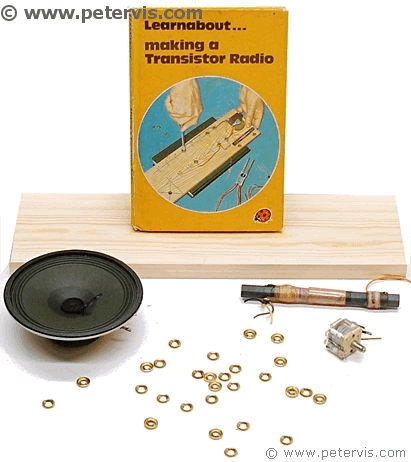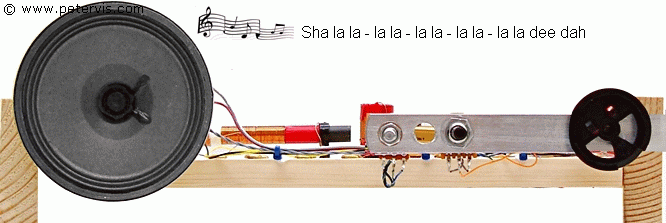Making a Crystal Radio Electronics Lab
In this project, we look at making a simple crystal radio in the form of an electronics lab, so you have all the components necessary to experiment with adding transistor stages should you wish to do so. Back when I was a little whippersnapper, I used to make crystal radios when life’s rain fell, and when it was sunny again we would be skipping and jumping, and hiding behind a rainbow. This is a wonderful project for everyone; it does not matter if you are rich or poor, because the rain falls on everyone equally. My nephews found this wonderful old Ladybird book called Making a Transistor Radio and wanted to build one. Of course, building a radio is expensive these days, so I figured I had better look in the shed to see if I had anything left of the radio I made back when I was a young whippersnapper.
The Rain Came...
Unfortunately, the rain through the broken roof did not help much and the woodworm had a good meal on it. If memory serves, the baseboard was a school project in my Woodwork class.
The original crystal earpiece, which is made of plastic, managed to survive; it would cost a fortune today. The ferrite rod together with the coils was still there, but the coil had badly tarnished. The brass screw cups were tarnished, and the loudspeaker paper had perished.
The trimmer plates had rust, and there was no tension in the plates to keep them apart. I remember breaking the screw thread when I last used it. I really hate those old-fashioned trimmers; they are awful nasty things... You end up turning the screw this way and that, and eventually either the screw breaks, or the plates remain stuck!
Dr Frankenstein's Germanium Transistors...
The ancient OC45 and OC71 germanium transistors did not make it in the rain either. The terminals had corroded, and they were showing short on the meter. They were awful unreliable things anyway, which is why the industry switched to silicon transistors.
For some reason, germanium transistors always go short, even when not used. You store them away for a couple of decades and they stop working! It was a poor design and construction. The early OC71 transistors had a smearing of non-conducting grease and then sealed in a metal can with helium. If the gas escaped, then the transistor would develop oxidation within its junctions and fail to work. I always knew these transistors were full of gas. :-)
An expert told me that you could connect them to a 9 V DC battery and jolt them back into life, however I think I will just throw them away. Nobody uses germanium transistors these days, except electric guitar players with their fuzz boxes.
We Want the Same!

I had very little to go with, and the budget was small, so I decided to make them simple crystal radios, with the possibility of adding extra transistor stages in the future. They could also use it as a development system for testing out transistor amplifier circuits.
I had just enough money for extra screws and a larger board, so I decided to make them something that could be used as an electronics science fair type development system. I could include a speaker, volume controls, and an LT700 transformer. They can then try out simple circuits from the Internet to their heart's content.
Unfortunately, my nephews wanted the exact same radio as shown in the ladybird book, because of the colourful diagrams and the concept of the screw cup system.
"Honestly guys, you don't want to make that radio. I remember making it when I was your age, and mostly I heard hissing and farting noises from it. :-)" I said.
"The radio uses regeneration, which is a form of feedback method where the same signal is fed back into the same transistor three times over. You get awful feedback, and you end up hearing whistling, burping, farting, howling, and hissing sounds. You do not need to buy £15.00 worth of germanium transistors for that, just go and listen to your dad instead :-)" I explained.
"We want the same!" they said, as they stamped their feet together in perfect harmony. Amazing thing, DNA, I seem to remember their parents doing the same thing as well. I gave them three options; 1. They could either have one Ladybird Book radio to share between themselves, and pizza for only one week. 2. They could have two Ladybird book radios, from a four weeks pizza budget, therefore no pizza for a month! 3. They could have nice crystal radios that look the same, for each, and Pizza.
Hey, my clients are very perceptive; they know exactly what is good for them, especially when pizza is at stake, which is why they chose option three.
I am certainly not going to pay a fiver for one germanium transistor, not in this inflationary climate, and there must be many poor whippersnappers who would like to build a simple crystal radio, together with a science fair type system for experimentation.
After much collaboration with my top engineers in Japan, radio experts in the USA, and scientists working for NASA, I managed to come up with a design for a development system. In this design, I am including some volume controls, a speaker, and an audio transformer so that it could be used as an electronics development system for experimenting with circuits. You do not have to include all of that though if you are building just the crystal radio. The extra components are there so that the whippersnappers could build a single transistor amplifier to see how it works. They could also connect other circuits from their GCSE course for experimentation.
The Little Whippersnapper's Crystal Radio is born
Thus, the project began, to build a crystal radio. I decided to call it The Little Whippersnapper's Crystal Radio, so that all the little whippersnappers throughout the length and breadth of the land could buy the parts from their pocket money. It will fill their little hearts with great joy of being able to tune into Radio 4 to listen to educational programs, just as I did when I was a young whippersnapper. :-)
I believe this radio will keep your little whippersnapper occupied for many hours, as there are lots of little screws and components to fiddle research with. I guarantee that before he is even potty trained, he will be adding amplifier stages to it, and calling himself a Computer Scientist just like Larry and Sergey. :-)
This Article Continues...
Making a Crystal Radio Electronics LabMaking a Crystal Radio - The Little Whippersnapper's Parts List
Crystal Radio Baseboard 4-inch by 12-inch by 1/2-inch
No. 6 Brass Screw Cups & No. 6 Screws 1/2-inch
Marking Out the Baseboard and Installing the Screws
Making the coil
Crystal Radio Coil
Crystal Radio Coil Winding
Crystal Radio Coil Terminals
Connecting the Crystal Radio Coil
Main parts
Crystal Radio Diode
Germanium Diode Test
Crystal Radio Earphone
Crystal Radio Circuit
Crystal Radio Specification
Optional
Potentiometer Mounting Bracket
RFC - Radio Frequency Choke
Project Power Supply Wiring
10k Potentiometer Wiring
BC549C Lead Extensions for Future Amplifier Projects
Wiring the Speaker to the LT700 Transformer
Credits
The Little Whippersnapper's Radio
